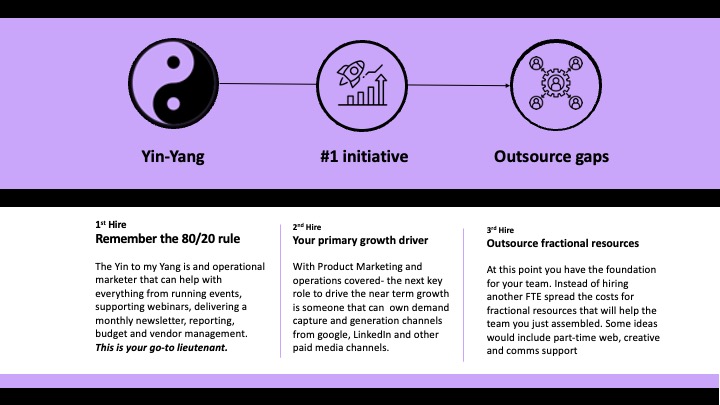
A step-by-step guide to building your SaaS startup marketing team
Hint: It’s not the same as a Fortune 500 enterprise.
Imagine this: You are embarking on your first marketing leadership role at a startup. The growth objectives are audacious. There's an urgent need to create awareness of something new, generate demand and scale operations. Plus, you need to build a team from ground zero.
Sound familiar?
If so, it’s safe to assume you’ve experienced this or are entering a similar role. In that case, it can be tempting to turn to popular online resources or to rely on your prior experiences at big corporations for guidance. However, drawing a parallel between the marketing team structures of a behemoth like Google or Oracle and that of a budding SaaS startup is like comparing the Imperial Death Star to a Rebel X-wing Fighter. One is well-resourced and relies on brute force, while the other is nimble and agile. Each have different objectives which dictate a different strategy.
It's tempting to emulate Fortune 500 companies, but doing so would be a costly mistake for your startup.
The difference between Fortune-500 marketing structures and SaaS startups
Fortune 500 marketing teams have a distinct focus: control costs, optimise processes, maximiz=se efficiency, and allocate resources based on ‘organisational dynamics’ (i.e., the most senior executive in the room).
On the contrary, a SaaS startup marketing team needs to focus on:
- Rapid experimentation and agility
- Rapid customer acquisition with little to no brand capital
- Brand awareness and positioning in a noisy space

With contrasting objectives, it's evident that their structure should not be used to guide your teams’ structure.
Building your startup marketing team
Before building the right team, it’s important to understand the philosophical underpinning of why taking a novel approach to hiring and team structure is necessary. Focus on these three key principles, first:
- ‘What got you here won't get you there’.
Focus on building the most efficacious team for today’s goals and business challenges, not a team you think you might need in 3-5 years. Or put another way, what you need now will differ significantly from what you require in the future. The ideal marketing team requires different talents, mindsets, and processes depending on where you are in your growth journey. For example, building and getting to product market fit with an early-stage marketing team demands different skills than a company at its Series-C stage.
- A culture-first mindset trumps a skillset at the early startup stage.
You need agile team players who thrive at being flexible to market and product dynamics. These first hires love to rapidly learn, are builders and are comfortable being uncomfortable. As your startup matures, more processes and frameworks will be established; this is where role players will be more appropriate.
- Your startup is not a talent development factory.
Large enterprises and late-stage startups have established processes & SOP’s, learning and development infrastructure, and new employee onboarding plans. Your first hires shouldn’t need most of those things and should be self-starters – they are the ones building the onboarding programs and frameworks for your scale stage.
Making the right initial hires
Don't underestimate the importance of your first few hires. Taking a strategic and agile approach to building your team can lay the foundation for your success in the future.
- Your 1st hire: remember the 80/20 rule.
80% of the results come from 20% of the efforts. What tasks consume most of your time but aren't critical for you to manage? Instead of trying to fit roles based on a predetermined mold, look for ‘t-shaped or π-shaped’ individuals with a broad range of skills but deep expertise in one or two. Hire a complimentary team member that allows you to load-shed and delegate to free up your calendar, so you can focus on what marketing super-powers you possess.
- The 2nd hire: identify the primary growth driver for your startup.
Your second hire should be able to own and deliver on your startup’s number one growth driver. Is it digital marketing demand gen tactics, or KoL and community building, a branding and comms motion or a field and events strategy? Once you identify the key program, seek out the best talent available, empower them to take ownership of driving growth and give them the needed (and dedicated) resources to make it happen. They must be solely focused (and responsible) on delivery for the identified growth KPI.
- The 3rd hire: think outsourcing vs. in-house hiring.
Not every role requires a full-time position. For capabilities that are needed ad-hoc and not part of your long-term competitive advantage, fractional or nearshored services can be a great option that are more efficiently managed. Some roles that fit this description could be one-and-done tactics or where it would be too expensive to resource in-house as a small team, e.g., web development, media relations, copywriting, and/or graphic design.
Real-life example...

Avoid the ‘pre-plan’ hiring trap
It's common to believe that every SaaS startup needs a content marketer, a product marketer, and a digital marketer. But what if your CEO is an outstanding product-driven leader? Allocating a significant chunk of your team to product marketing would be redundant. Similarly, if you're navigating a complex sales landscape with established, highly trained, and expensive account executives, is there a need for a digital marketer to generate leads or a content marketer to push out blogs?
Emulating Fortune 500 structures for startups can be counterproductive. Instead, focus on your startup's unique goals, and build a team that aligns with those objectives. Remember that your team's composition will evolve as your startup grows, so remain agile and adaptable in your approach to team building. Evaluate your team's capabilities every six months to see if they still align to the corporate and GTM strategy.
In the rapidly changing landscape of the SaaS industry, assembling a dynamic and efficient marketing team can make all the difference between success and a reduction in force (RIF). Understanding the broader go-to-market goals and embracing a flexible mindset will create a marketing dream team that accelerates your growth.
The bottomline
Avoid the temptation to mirror Fortune-500 structures; focus on building your rebel fighter X-wing fleet, not a monolithic Death Star.

